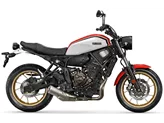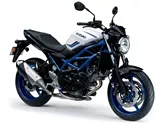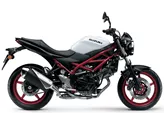Suzuki SV 650 2017 vs. Yamaha XSR700 2017

Suzuki SV 650 2017

Yamaha XSR700 2017
Overview - Suzuki SV 650 2017 vs Yamaha XSR700 2017
The Suzuki SV 650 2017 and the Yamaha XSR700 2017 are both naked bikes that offer a thrilling riding experience.
In terms of engine performance, the Suzuki SV 650 has a V-twin engine with 76 HP of power and 64 Nm of torque, while the Yamaha XSR700 has an in-line twin engine with 75 HP of power and 68 Nm of torque. Both bikes have fuel injection systems and liquid cooling. The Suzuki SV 650 has a displacement of 645cc, while the Yamaha XSR700 has a displacement of 689cc.
In terms of suspension, both bikes feature telescopic forks in the front and swing arm suspension with a monoshock in the rear. The chassis of both bikes is made of steel, providing stability and durability.

Suzuki SV 650 2017
When it comes to braking systems, the Suzuki SV 650 has double disk brakes with a diameter of 290mm and double piston calipers in the front, while the Yamaha XSR700 has double disk brakes with a diameter of 282mm and four piston calipers in the front. Both bikes are equipped with ABS for advanced rider assistance.
In terms of dimensions and weights, the Suzuki SV 650 has a front tire width of 120mm, a rear tire width of 160mm, a wheelbase of 1445mm, and a seat height of 785mm. It has a kerb weight of 197kg (with ABS) and a fuel tank capacity of 13.8 liters. On the other hand, the Yamaha XSR700 has a front tire width of 120mm, a rear tire width of 180mm, a wheelbase of 1405mm, and a seat height of 815mm. It has a kerb weight of 186kg (with ABS) and a fuel tank capacity of 14 liters.
Now let's discuss the strengths and weaknesses of each bike.

Yamaha XSR700 2017
The Suzuki SV 650 2017 is praised for its smooth engine, playful handling, and great chassis. However, it is criticized for having weak brakes.
On the other hand, the Yamaha XSR700 2017 is appreciated for its wonderful engine, solid workmanship, cool retro look, and a large range of original accessories. It also offers a great automatic gearshift, sporty and tight chassis, and is easy to drive. It is considered a joy dispenser for riders of all ages. However, it has some weaknesses including the readability of the display, the license plate holder being a matter of taste, and a lack of consistency in some design details. Additionally, due to its concept, it provides poor wind protection when driving at high speeds.
In conclusion, both the Suzuki SV 650 2017 and the Yamaha XSR700 2017 are impressive naked bikes with their own strengths and weaknesses. The Suzuki SV 650 offers a smooth engine and playful handling, while the Yamaha XSR700 provides a wonderful engine, solid workmanship, and a cool retro look. Ultimately, the choice between these two bikes will depend on the rider's preferences and priorities.
Technical Specifications Suzuki SV 650 2017 compared to Yamaha XSR700 2017
Pros and Cons in comparison
Pros and Cons in comparison
Suzuki SV 650 2017

The Suzuki SV 650 is accompanied by a long history of success that is sure to continue for a long time. Its supple V2 impresses with very smooth response and plenty of torque. Compact dimensions help to make the motorbike look very compact. This will be very convenient for beginners. The chassis also scores with playful handling. Unfortunately, the braking effect is not at the level one would expect from such a powerful vehicle.
Yamaha XSR700 2017

The XSR is the perfect everyday bike for me. It is visually a feast for the eyes, has an incredible amount of power, but is still light and agile. The seating position allows longer rides, as the luggage can be carried on the back without any problems. The XSR itself doesn't know exactly what it wants to be now. But I find the resulting mix quite exciting. So if you don't want to (or can't) have different bikes in the garage, the XSR is a very good choice. served very well. It has everything you expect from a motorbike. In a hotel, one would speak of an all-inclusive offer. It is perfect for It is perfect for the daily ride to the office, for weekend excursions and smaller tours to the south. Even with a pillion, the bike is very easy to move. As usual from Yamaha, the bike makes a very solid impression. Everything simply works here. The exhaust is pleasantly quiet, but from 5000 rpm it produces a very appealing and throaty sound. The rear end is a matter of taste. Personally, I would rebuild the rear and remove the plastic elements. I also find the standard mirrors a little large. The retro look was not quite carried through here. However, this can be changed very quickly and easily thanks to the many accessories. The instrument panel is basically easy to read. However, a lot of information is space. Here, design and functionality clash a little. Summarised in one sentence: The perfect bike for every challenge.
Price Comparison Avarage Market Price Suzuki SV 650 vs Yamaha XSR700
There are a few key differences between a Suzuki SV 650 2017 and a Yamaha XSR700 2017. In terms of price, the actual average price of a Yamaha XSR700 2017 is about 12% higher. Compared to Yamaha XSR700 2017 there are less Suzuki SV 650 2017 bikes available on the 1000PS.de Marketplace, specifically 6 compared to 7. It takes less time to sell a Yamaha XSR700 with 91 days compared to 112 days for the Suzuki SV 650. Since model year 2005 1000PS.de editors have written 25 reviews for the Suzuki SV 650 and 26 reviews for the Yamaha XSR700 since model year 2015. The first review for the Suzuki SV 650 was published on 9/26/2008 and now has more than 14,200 views. This compares to more than 13,700 views for the first review on Yamaha XSR700 published on 7/22/2015.



















